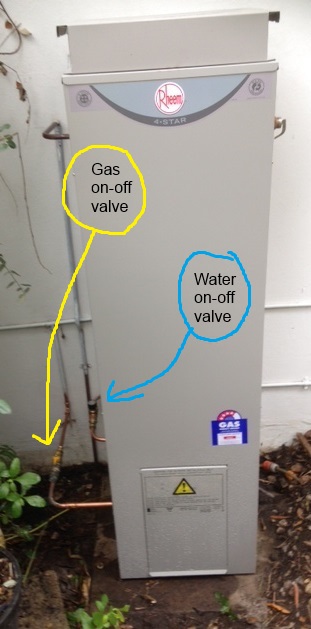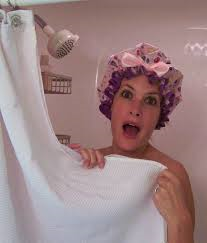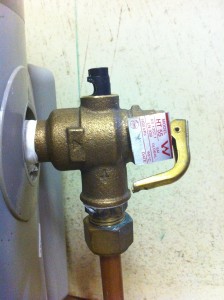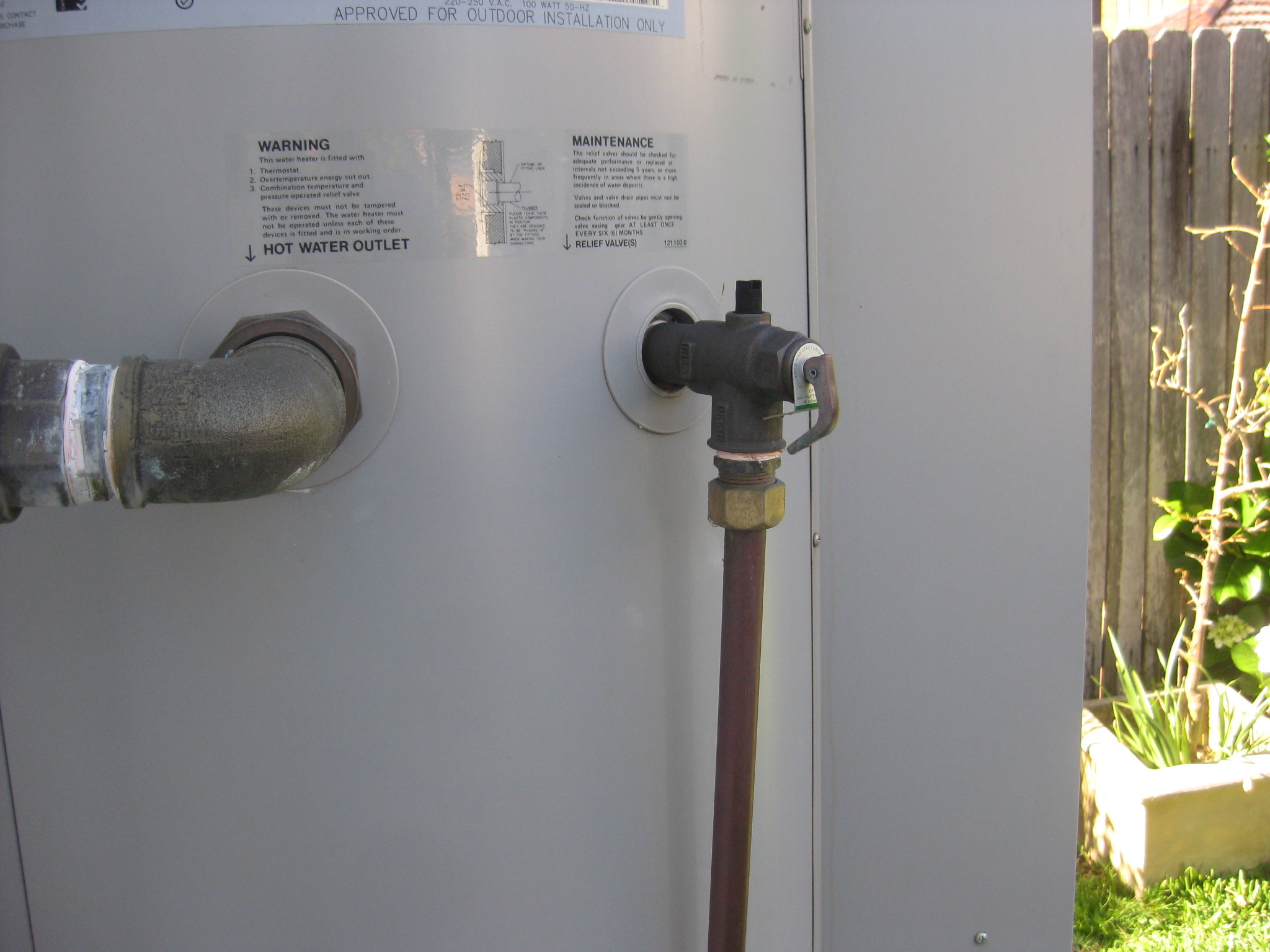Archives
Know your water heater #2
The hot water tempering valve
Knowledge about your water heater will save you money!
Second in the series, this 44-sec clip will show you a typical tempering valve on a gas water heater. That’s the blue valve on the side of the heater.
It should be checked by your plumber annually and replaced every five years.
The tempering valve is fitted to prevent scalding of the aged, the infirmed and young kids. It should be on every storage(and continuous) water heater like this.
If you are changing or upgrading your water heater, you should have a Tempering valve fitted.
Get into hot water this Winter!
With the winter season underway, its time to think about hot water.

Take 10 minutes to check on your water heater.
Is it gas or electric?
Check it’s location. Ensure that it’s not leaking on any of the pipes or connections.
Check the cold water control feed tap, usually on the bottom left of the heater. Make sure it turns off and back on.
If you have a storage tank, make sure you check the pressure relief valve is working correctly. And that it’s not leaking.
An efficient water heater will supply all the hot water your family will need this winter.
If you’re not sure, call me on 02 9664 4990!
Know your water heater #1
Hi, its Dave Conroy here from The Lone Drainer and Pronto.
As we approach the winter of 2020, my message for today is about hot water.
You need to know how to turn off the water supply to your water heater.
And most importantly, I want you to know what a temperature and pressure relief valve is.
This 1min 48 sec YouTube clip will show you how it’s done on a 50-litre heater. Yours may be different. If you would like to know more……Call me!
Urgent hot water help
Its really important to know a few simple things about your water heater.
I just had an emergency call from Emma, who returned from visiting the UK for Christmas. While she was away her water heater leaked through the kitchen cupboards, ruined the carpet throughout her home and flooded the property below.
The neighbour below had to force entry into her unit to turn off the water to protect his property.
Over the phone, Emma asked for help replacing her existing water heater.
I asked her to send a picture of the heater and I now know:
- There is no safe tray under the heater. Installing a safe tray to prevent future flooding should be considered.
- The water heater currently is an 80Ltr unit. The modern version is slightly larger and won’t fit in the cupboard. The cupboard may need to be dismantled to remove the existing and fit a new unit.
- A 50-litre heater may also be too big. (Please check the cupboard dimensions)
- The current water heater does not have a tempering valve fitted. Australian Standard states “A tempering valve to be a part of any new hot water installation”.
- There is a flexible connection between the Duo valve and the heater. Australian Standard states “Flexible connections do not comply”.
Does the cold water control valve that shuts off the water to your entire home work efficiently? It will need to, so that the Duo (control) valve the water heater can be worked on.
Take 3 tips.
- Know where your water heater is.
- Know how it turns off.
- Turn off the water and electricity or gas before you go on holidays.
If you’re not sure…ask me.
My Plumber is a Wizard
Sometimes its great to laugh at ourselves.
I’ve always loved the Wizard and this is a good one!

Help! Where does my Hot Water turn off?
“HELP!“
“My water heater is spitting out hot water and steam. Can you get over here Urgently?” “I don’t know how to turn it off and I think it’s going to explode!”
Monday morning brought a call from Deborah in Randwick. It sounds like a job for The Lone Drainer ……and Pronto.
Of course we were able to rescue Deborah. We replaced the water heater and the gas and water shut-off valves that controlled the unit. But, how many people don’t know how to turn off their water heater?
The image below shows where to shut off the water and gas supply to the heater. Why don’t you practice turning the water heater off when it isn’t urgent?
If you need help Call us 02 9664 4990

Who turned off the hot water?
Who turned off the hot water?… That was the call today from the residents in a block of 82 home units.
Our clients shower tap was leaking; a 1/2 bucket of hot water every minute and needed new washers.
So, “Where does the Hot Water turn off?” asked The Lone Drainer. “I don’t know”, replied our client! What followed was a search for the hot water shut off in all the usual places; under the vanity basin…. no; under the kitchen sink…. no; in the bathroom ceiling…. no; what about the duct in the hallway…. no!
Next, The Lone Drainer called the maintenance manager’s mobile, courtesy of the Emergency Number notice in the foyer. When he finally responded, The Lone Drainer and Pronto already knew that the valves in the cupboard shut off all the units on the other side of the hallway, but not ours.
“The hot water shut off valve should be in that duct” said Al the manager. “It’s not!” said The Lone Drainer. “Any suggestions?”
“So you’re gonna have to shut down hot water for the whole building” says Al.
 Now there is a protocol for shutting down water to a building with 82 units at midday. Normally it’s a notice on the board and in the lift a couple of days in advance. Not today!
Now there is a protocol for shutting down water to a building with 82 units at midday. Normally it’s a notice on the board and in the lift a couple of days in advance. Not today!
I had Pronto go to the foyer and buzz every unit to tell those that answered that the hot water is gonna get turned off in 1/2 hour for about 1/2 an hour.
By the time we shut down the boiler, drained the building then removed the shower tap and re-washered it, replaced O-rings and lubricated the moving parts, put the tap back together and turned the boiler valves back on, an hour and 15 minutes had gone by. Luckily only 18 of 82 residents came looking for the reason they had no hot water on this cold Sydney day.
Moral of the story:
Know where your hot and cold water turns off…. And make sure it does! Now, that sounds like a job for The Lone Drainer and Pronto!
3 Tips for Healthy Hot Water
Who had a cold shower this morning?
Winter makes the need for hot water a high priority. If you think your heater is under performing do this quick water heater health check.
1. Check the colour of your water. If its brown, your water heater has a buildup of sediment or rust.
2. Check your Temperature and Pressure Relief valve (like the one shown below), pull the lever; it should spurt out water till you let go of the lever. If it dribbles afterwards, it needs attention.
3. Does the stop valve work? Try turning it off, test the water at your hot taps and turn it back on. Ideally it should stop the water flow through the heater.

Whether your water heater is gas or electric, storage or continuous, check it regularly.
If your hot water runs out get your friendly plumber to check it over
Washing machines & dishwasher maintenance
With 3 growing boys living at home who eat like there is no tomorrow, between playing rugby, cricket and doing patrols at Coogee Surf Club, we have plenty of dishes to wash up every day as well as laundry to do every day, so much so, that both appliances broke down at the same time!
Yes it happens to plumbers as well!
So we had our brightest plumbing apprentice just install a new dishwasher and washing machine and it made me aware of the importance of these water appliances and how we should maintain them.
1. Their hoses are rubber, so with hot water they perish and may rupture; so check them regularly.
2. Many people turn these control valves or taps off at the end of every wash. In our house that would be impossible.
3. Turn taps off when going on holidays. Don’t forget to turn them back on when you return.
Just recently, our emergency plumbers rescued a young mother who had been to Adelaide for three weeks. The hose feeding her washing machine ruptured causing many dollars worth of damage:
- Her washing machine shorted out electrically (needs a new machine).
- The laundry/bathroom was covered in mould from the steam (needs repainting).
- Assorted bits and pieces of furniture were damaged.
- The carpets in the hallway were waterlogged.
- The parquet flooring at the end of the hallway had buckled and would need major repairs, then re-sanding and staining.
- Not to mention the aggravation of removing all furniture and of course taking the young children away from the home for several days whilst these procedures were carried out. The fumes from the floor staining were intoxicating.
7 easy ways to extend the life of your Water Heater
Have you found yourself in a situation where its winter and you head home for a shower after work, or after a rugby or netball training session, turn on the hot water tap and the water is cold?
There are many plumbing fixtures around your home, the bath or hand basin, kitchen sink, of course the toilet. Some homes, offices and small business have multiple toilets, showers and basins.
As we move into the cooler months the average hot water heater becomes more important for all these plumbing fixtures to work.
Its easy to take these often ignored assets in your home or office for granted, but some simple actions will prolong the life of your storage water heater.
Replacing your hot water heater can usually be unexpected and sometimes expensive, but in today’s fast moving world we can easily ignore this vital cog in our daily routine.
So be sure you are aware of the following:
- Where is your water heater? You need to know where it is!
- Is it gas or electric? You need to know!
- Can you turn off the gas or electricity?
- Can you turn off the water supply to your heater? Try it! Check this valve or tap works
- Is it a mains pressure storage heater or instant (continuous)?
- If it is mains pressure, have you released the Temperature and Pressure Relief valve (T&PR valve)?
- Keep the area around this heater clean and clear. Keep long grass, paint cans etc. well clear.

T&PR valve on mains pressure external gas water heater
See the “hook” on the Temperature and Pressure Relief valve, lift it and hold it up for 30 seconds at least every three months. If this is working properly, it will discharge the hot water whilst you hold up the hook, then stop when you let it go. It is normal for it to discharge water while the heater is heating. Then the water should stop! Be careful the hot water doesn’t scald you.
Our water heater is a friend, if you are ever unsure about how your water heater is performing, or have any questions about any of the things we have outlined here, contact a professional plumber for guidance.
Remember to engage a licensed plumber to attend to your hot water heater.
https://www.thelonedrainerandpronto.com.au/hot-water-services.html
How to Prolong the Life of Your Mains Pressure Hot Water Heater
The lifespan of a water heater is about eight to twelve years, depending on whether it is inside or out, near the ocean, or you carry out simple maintenance procedures. Modern tanks are lined with steel, and this lining can break down over time.
Here are some tips to prolong the life of your mains pressure hot water heater.
- Installing a second anode rod prolongs the life of the water heater. The anode rod undergoes corrosion as time moves on and collects this corrosion in order to prevent so much corrosion in the tank.
- A pressurised system needs a Temperature and Pressure Relief valve to be working effectively in order to prolong the life of the water heater. As water heats, it expands and needs somewhere to go. A T&PR valve will prevent stress on the water heater and the hot water plumbing system by taking the discharge.

Ease this valve regularly
- Annual flushing of an older tank will help keep it working and prevent sedimentary build-up inside the tank. Newer tanks are often self-cleaning; they may cost more but are able to last for many years to come.
- Very high water pressure can damage your appliances and cause the water heater to wear out too early. Installing a pressure limiting valve regulates system pressure and reduces the wear and tear on your hot water plumbing and your appliances.
- Scaling is a big problem for water heaters in areas where the public water systems have excess mineral contents. In many instances a water softener is the answer to this problem. The water softener reduces wear and tear on the water system and helps your soap suds up better.
Should your water heater stop working for you, be sure to call in emergency plumbing services and restore the hot water supply back in your house. The Lone Drainer and Pronto plumbing services have an emergency plumbing services number where you can reach a professional plumber twenty four hours a day to take care of any problem you may be having with the plumbing. NEVER attempt to do it yourself as you do require a qualified plumber to assist you in this situation.
Follow the suggestions mentioned and prolong the life of your mains pressure hot water heater. You want the hot water heater in your home or business to perform exactly as it should at all times. By taking care of the water heater and making sure you cover most of these things, you will save yourself the expense of replacing a whole system or the frustration of not knowing just what to do when the whole thing seems to be under performing or even leaking.
It is never nice to have a plumbing emergency, but in the unfortunate circumstance that you do, it is good to know that emergency plumbing services are available. Many reputable companies will come back the next day with a follow up to make sure that everything is working the way it is supposed to, as well as to make sure that there are no more immediate problems that could potentially shut your water off for an extended period of time.
When you have to choose a regular plumber, be sure that they have plumbing services for any emergency and reasonable charges for their plumbing services. They should also give you a price for the job upfront, before they start.
https://www.thelonedrainerandpronto.com.au/hot-water-services.html
Problems with hot water during the long hot summer?
Welcome to 2010!
Over the Christmas and New Year period we were called to rescue people with all sorts of plumbing emergencies!
Burst water pipes, blocked sewer drains, leaking taps and toilets are commonplace, but, here at the height of summer, calls for help for running hot water is at an all time high!
Ruptured water heaters or burst water heaters happen all the time and we only think of it as a problem in the winter, but we love a warm shower in the summer just as much.
Try telling a family that we can’t replace their particular type of heater over the holidays, because…………..ahhhhhhhh!
So here are a few simple tips that will assist:
1. Know where your water heater is. You would be surprised how many people don’t know where their water heater is!
2. Know how to turn your water heater off.
3. Try turning your water heater off to check that the cold water valve that turns it off works. One emergency water heater job we went to on Boxing Day, could have saved the owner money if they could have simply turned their heater off at the control valve or tap. The tap would not work, so we had to shut down the entire house, cut out the faulty tap valve and fit a new valve. We then turned the water to the house back on, so our clients at least had cold water to flush the toilet, make a cuppa and have a cold shower until we could track down the appropriate new water heater that was needed.
4. Pull the pressure relief valve on your mains pressure water heater, let it run for 5 or 10 seconds. When you let the valve go the water should slow down and then stop. If it does not stop, try it again. The pressure relief valve should be eased at least every 6 months.
5. Make sure its dry and clean around the base of your water heater storage area. Keep it clear of leaf debris, and long grass if it is outside.
6. Don’t store flammable liquids, petrol or paint anywhere near a gas water heater.
https://www.thelonedrainerandpronto.com.au/hot-water-services.html
Green Loans
Green Loans have been set up by the Australian Government in order to provide subsidised loans to assist in making houses more environmentally friendly. This is a great way to provide financial assistance to households to gain access to the resources they need to invest in energy and water efficient technologies, and hence reduce total greenhouse emissions from domestic households. After undertaking a free “home sustainability assessment”, owners or tenants of eligible homes are allowed to take out a loan of up to $10,000 at zero interest in order to make the changes suggested in the assessment.
The assessment is carried out by a qualified expert assessor and will provide advice from the smallest behaviour change to major investments such as photovoltaic panels or a solar hot water system which can be installed by your local plumber. The assessment itself is also completely free and should only take around 1.5 hours. While only one green loan can be made per assessment, this loan can be used to carry out a number of different projects.
Funding for these loans is obviously limited so those interested should act fast. If you would like to be considered for a loan, book a Sustainability Assessment by calling the hotline on – 1800 895 076.
More information is available at http://www.environment.gov.au/greenloans/
